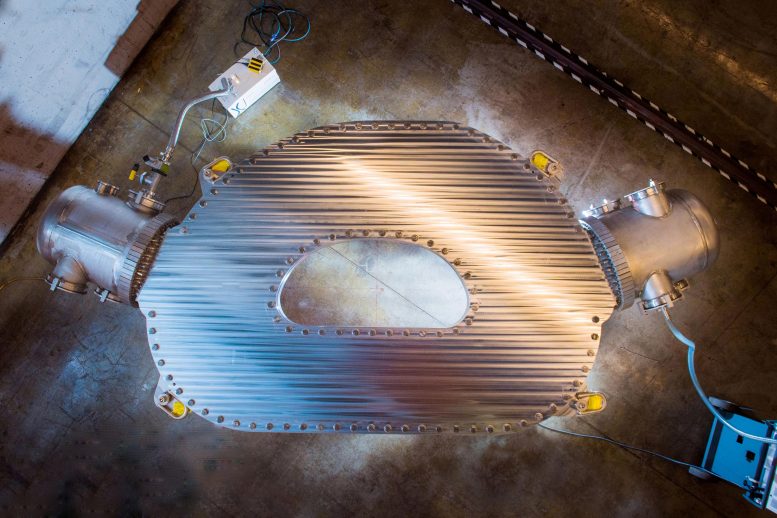
This large-bore, full-scale high-temperature superconducting magnet designed and built by Commonwealth Fusion Systems and MIT’s Plasma Science and Fusion Center (PSFC) has demonstrated a record-breaking 20 tesla magnetic field. It is the strongest fusion magnet in the world. Credit: Gretchen Ertl, CFS/MIT-PSFC, 2021
New superconducting magnet breaks magnetic field strength records, paving the way for practical, commercial, carbon-free power.
It was a moment three years in the making, based on intensive research and design work: On September 5, for the first time, a large high-temperature superconducting electromagnet was ramped up to a field strength of 20 tesla, the most powerful magnetic field of its kind ever created on Earth. That successful demonstration helps resolve the greatest uncertainty in the quest to build the world’s first fusion power plant that can produce more power than it consumes, according to the project’s leaders at MIT and startup company Commonwealth Fusion Systems (CFS).
That advance paves the way, they say, for the long-sought creation of practical, inexpensive, carbon-free power plants that could make a major contribution to limiting the effects of global climate change.
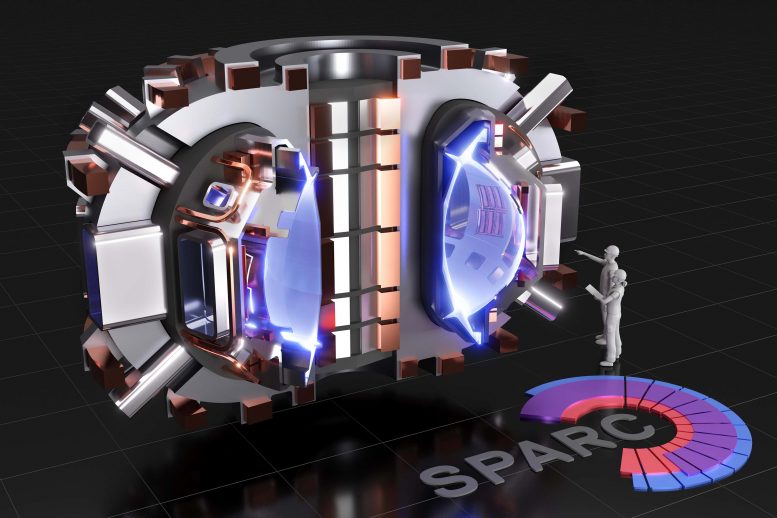
Rendering of SPARC, a compact, high-field, tokamak, currently under design by a team from the Massachusetts Institute of Technology and Commonwealth Fusion Systems. Its mission is to create and confine a plasma that produces net fusion energy. Credit: T. Henderson, CFS/MIT-PSFC, 2020
“Fusion in a lot of ways is the ultimate clean energy source,” says Maria Zuber, MIT’s vice president for research and E. A. Griswold Professor of Geophysics. “The amount of power that is available is really game-changing.” The fuel used to create fusion energy comes from water, and “the Earth is full of water — it’s a nearly unlimited resource. We just have to figure out how to utilize it.”
Developing the new magnet is seen as the greatest technological hurdle to making that happen; its successful operation now opens the door to demonstrating fusion in a lab on Earth, which has been pursued for decades with limited progress. With the magnet technology now successfully demonstrated, the MIT-CFS collaboration is on track to build the world’s first fusion device that can create and confine a plasma that produces more energy than it consumes. That demonstration device, called SPARC, is targeted for completion in 2025.
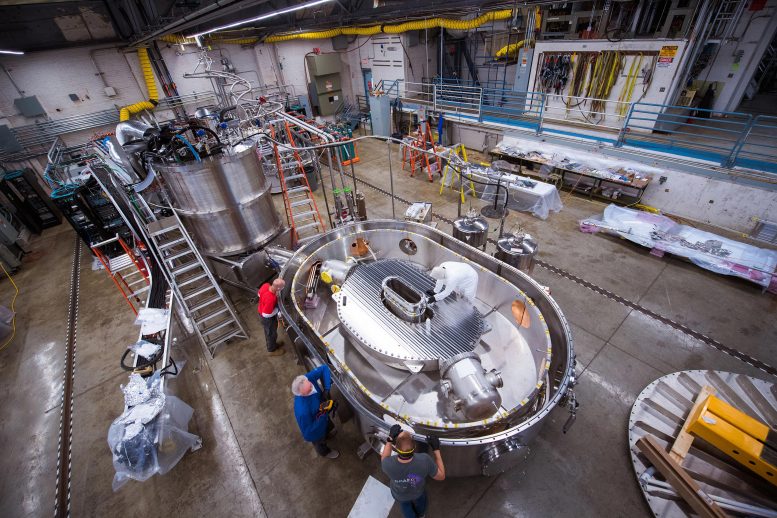
Collaborative team working on the magnet inside the test stand housed at MIT. Research, construction and testing of this magnet has been the single largest activity for the SPARC team, which has grown to include 270 members. Credit: Gretchen Ertl, CFS/MIT-PSFC, 2021
“The challenges of making fusion happen are both technical and scientific,” says Dennis Whyte, director of MIT’s Plasma Science and Fusion Center, which is working with CFS to develop SPARC. But once the technology is proven, he says, “it’s an inexhaustible, carbon-free source of energy that you can deploy anywhere and at any time. It’s really a fundamentally new energy source.”
Whyte, who is the Hitachi America Professor of Engineering, says this week’s demonstration represents a major milestone, addressing the biggest questions remaining about the feasibility of the SPARC design. “It’s really a watershed moment, I believe, in fusion science and technology,” he says.
The sun in a bottle
Fusion is the process that powers the sun: the merger of two small atoms to make a larger one, releasing prodigious amounts of energy. But the process requires temperatures far beyond what any solid material could withstand. To capture the sun’s power source here on Earth, what’s needed is a way of capturing and containing something that hot — 100,000,000 degrees or more — by suspending it in a way that prevents it from coming into contact with anything solid.
That’s done through intense magnetic fields, which form a kind of invisible bottle to contain the hot swirling soup of protons and electrons, called plasma. Because the particles have an electric charge, they are strongly controlled by the magnetic fields, and the most widely used configuration for containing them is a donut-shaped device called a tokamak. Most of these devices have produced their magnetic fields using conventional electromagnets made of copper, but the latest and largest version under construction in France, called ITER, uses what are known as low-temperature superconductors.
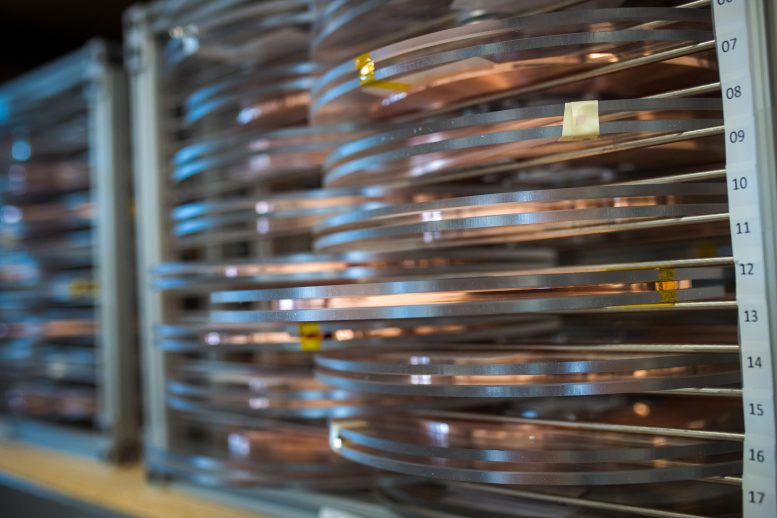
Spool of high-temperature superconducting tape used in the new class of fusion magnet. The magnet built and tested by CFS and MIT contains 267 km (166 mi) of tape, which is the distance from Boston, MA to Albany, NY. Credit: Gretchen Ertl, CFS/MIT-PSFC, 2021
The major innovation in the MIT-CFS fusion design is the use of high-temperature superconductors, which enable a much stronger magnetic field in a smaller space. This design was made possible by a new kind of superconducting material that became commercially available a few years ago. The idea initially arose as a class project in a nuclear engineering class taught by Whyte. The idea seemed so promising that it continued to be developed over the next few iterations of that class, leading to the ARC power plant design concept in early 2015. SPARC, designed to be about half the size of ARC, is a testbed to prove the concept before construction of the full-size, power-producing plant.
Until now, the only way to achieve the colossally powerful magnetic fields needed to create a magnetic “bottle” capable of containing plasma heated up to hundreds of millions of degrees was to make them larger and larger. But the new high-temperature superconductor material, made in the form of a flat, ribbon-like tape, makes it possible to achieve a higher magnetic field in a smaller device, equaling the performance that would be achieved in an apparatus 40 times larger in volume using conventional low-temperature superconducting magnets. That leap in power versus size is the key element in ARC’s revolutionary design.
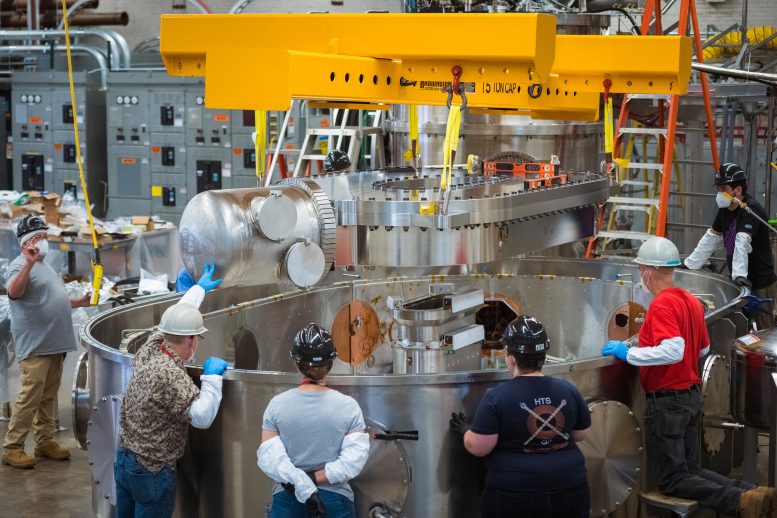
A team of engineers and scientists from CFS and MIT’s PSFC lower the superconducting magnet into the test stand in which the magnet was cooled and powered to produce a magnetic field of 20 tesla. Credit: Gretchen Ertl, CFS/MIT-PSFC, 2021
The use of the new high-temperature superconducting magnets makes it possible to apply decades of experimental knowledge gained from the operation of tokamak experiments, including MIT’s own Alcator series. The new approach, led by Zach Hartwig, the MIT principal investigator and the Robert N. Noyce Career Development Assistant Professor of Nuclear Science and Engineering, uses a well-known design but scales everything down to about half the linear size and still achieves the same operational conditions because of the higher magnetic field.
A series of scientific papers published last year outlined the physical basis and, by simulation, confirmed the viability of the new fusion device. The papers showed that, if the magnets worked as expected, the whole fusion system should indeed produce net power output, for the first time in decades of fusion research.
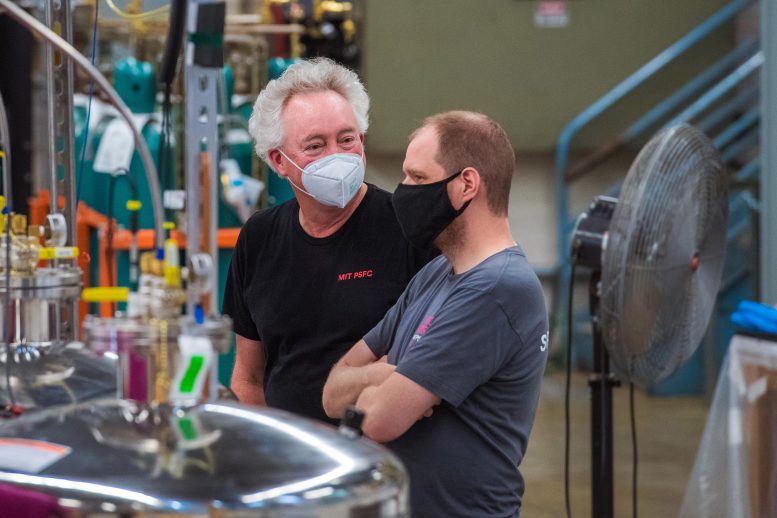
Director of the PSFC Dennis Whyte (L) and CEO of CFS Bob Mumgaard (R) in the test hall at MIT’s Plasma Science and Fusion Center. The collaboration which began over three years ago with the formation of Commonwealth Fusion Systems now moves to the next phase, building SPARC, which will be the world’s device to create and confine a plasma that produces net fusion energy. Credit: Gretchen Ertl, CFS/MIT-PSFC, 2021
Martin Greenwald, deputy director and senior research scientist at the PSFC, says unlike some other designs for fusion experiments, “the niche that we were filling was to use conventional plasma physics, and conventional tokamak designs and engineering, but bring to it this new magnet technology. So, we weren’t requiring innovation in a half-dozen different areas. We would just innovate on the magnet, and then apply the knowledge base of what’s been learned over the last decades.”
That combination of scientifically established design principles and game-changing magnetic field strength is what makes it possible to achieve a plant that could be economically viable and developed on a fast track. “It’s a big moment,” says Bob Mumgaard, CEO of CFS. “We now have a platform that is both scientifically very well-advanced, because of the decades of research on these machines, and also commercially very interesting. What it does is allow us to build devices faster, smaller, and at less cost,” he says of the successful magnet demonstration.
Proof of the concept
Bringing that new magnet concept to reality required three years of intensive work on design, establishing supply chains, and working out manufacturing methods for magnets that may eventually need to be produced by the thousands.
“We built a first-of-a-kind, superconducting magnet. It required a lot of work to create unique manufacturing processes and equipment. As a result, we are now well-prepared to ramp-up for SPARC production,” says Joy Dunn, head of operations at CFS. “We started with a physics model and a CAD design, and worked through lots of development and prototypes to turn a design on paper into this actual physical magnet.” That entailed building manufacturing capabilities and testing facilities, including an iterative process with multiple suppliers of the superconducting tape, to help them reach the ability to produce material that met the needed specifications — and for which CFS is now overwhelmingly the world’s biggest user.
They worked with two possible magnet designs in parallel, both of which ended up meeting the design requirements, she says. “It really came down to which one would revolutionize the way that we make superconducting magnets, and which one was easier to build.” The design they adopted clearly stood out in that regard, she says.
In this test, the new magnet was gradually powered up in a series of steps until reaching the goal of a 20 tesla magnetic field — the highest field strength ever for a high-temperature superconducting fusion magnet. The magnet is composed of 16 plates stacked together, each one of which by itself would be the most powerful high-temperature superconducting magnet in the world.
“Three years ago we announced a plan,” says Mumgaard, “to build a 20-tesla magnet, which is what we will need for future fusion machines.” That goal has now been achieved, right on schedule, even with the pandemic, he says.
Citing the series of physics papers published last year, Brandon Sorbom, the chief science officer at CFS, says “basically the papers conclude that if we build the magnet, all of the physics will work in SPARC. So, this demonstration answers the question: Can they build the magnet? It’s a very exciting time! It’s a huge milestone.”
The next step will be building SPARC, a smaller-scale version of the planned ARC power plant. The successful operation of SPARC will demonstrate that a full-scale commercial fusion power plant is practical, clearing the way for rapid design and construction of that pioneering device can then proceed at full speed.
Zuber says “I now am genuinely optimistic that SPARC can achieve net positive energy, based on the demonstrated performance of the magnets. The next step is to scale up, to build an actual power plant. There are still many challenges ahead, not the least of which is developing a design that allows for reliable, sustained operation. And realizing that the goal here is commercialization, another major challenge will be economic. How do you design these power plants so it will be cost-effective to build and deploy them?”
Someday in a hoped-for future, when there may be thousands of fusion plants powering clean electric grids around the world, Zuber says, “I think we’re going to look back and think about how we got there, and I think the demonstration of the magnet technology, for me, is the time when I believed that, wow, we can really do this.”
The successful creation of a power-producing fusion device would be a tremendous scientific achievement, Zuber notes. But that’s not the main point. “None of us are trying to win trophies at this point. We’re trying to keep the planet livable.”

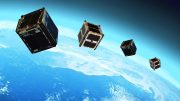


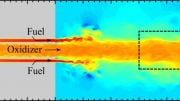
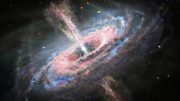
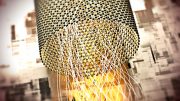
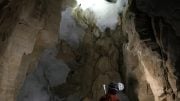

Bonjour….merci….
We’ve been getting hype about Fusion for decades. Please wake me up when they actually produce more energy than they consume.
Does this system necessarily require it to be built underground with an accompanying containment chamber included with the structure?
45.5-tesla
Magnet generates an unprecedented 45.5-tesla field. Scientists have created the world’s most powerful superconducting magnet, capable of generating a record magnetic field intensity of 45.5 tesla. Jun 12, 2019
I am always glad to see fusion progress, but….cummon….this is a crappy article. What is this 20 T important?
As I understand it, it’s important because that 45.5 Tesla field was produced using superconducting materials that needed to be kept ultracold. And that meant that the associated cooling requirements added bulk. This “high temp” superconducting magnet doesn’t have the same cooling requirements, thus eliminating bulk, and allowing it to produce the 20 Teslas in 1/40th volume (2.5%) it would take the old system to hit that same value. And because it is a fraction of the space you can stack it. So while 20 Teslas isn’t greater 45.5, 20 Teslas layered more than 40 times (though they only demonstrated 16 here) functionally is. Even though I suppose the actual Tesla rating stays at 20. Think of it like wood. An oak plank is significantly stronger than a pine plank, and always will be. But if you can stack 40 pine planks together for the same “cost” as the oak plank, the pine is functionally far superior. At least, if I have a grasp on the concept here.
We have had carbon free energy for 50+ years from fission, not that fusion people would ever like to admit as much. It’s like they are rewriting history.
No mention of what the fuel cycle will be presumably DT again. The CFS website seems to be quite bare of details, nothing on fusion physics, just lots of hype and pretty graphics showing students working on wooden benches. Seems like the real work is all in MIT space.
Also the article repeats the old high school myth the Sun is powered by smashing 2 atoms into 1 atom. It takes 4 input protons to make helium but 2 of those must be converted indirectly into neutrons via +ve beta decay.
The actual PP cycle is to convert proton pairs into deuterons which is extraordinarily dificult but can likely be skipped by using preexisting deuterium from the big bang. These deuterons or PNs are then merged with another proton to give Helium3 ie PPN. These are then smashed together to form regular Helium4 and 2 waste protons. This level of writing is never going to explain how the whole DT cycle is going to work.
That will be a game changer where fusion will power our spaceships for the future so we can discover different worlds at a time where wee will need to get off this planet !
And if the amazing article from Manchester University at front of SciTech is right, they can build their homes on other worlds from sweat, blood and tears and some wee wee, possibly some poo poo as well for added bulk.
And fusion isn’t going to power any spaceship soon either, not until well after climate cnahge has had its way with earth 1.0. So yeh, Startrek science is mostly just really bad junk science esp the Discovery series. The only good science on Startrek we have almost already done, in computers and medicine.
It would be awesome to have a massive one in space where you could attain 0 degrees easier. The energy produced could then be “safely” beemed to earth.
Space doesn’t work like that, think of the Space station, they produce a lot of energy from solar panels and then have a hard time to keep them cool, alot of radiators and refrigeration systems are at work.
Imagine a fission or fusion reactor in orbit, either one could create a great deal of heat but would have no way to remove the heat and dump it into anything. No chance at all to build the heat to electricty conversion systems. Perhaps on the surface of the moon facing us.
Fossil fuels were discovered how many hundreds or thousands of years ago? How many years did it take to build machines to use it in efficiently?
Even if it takes another hundred years to perfect fusion energy, it will be soon enough.
Now let us say this planet of ours Earth is the recipient of magnetic force and it relies on this force to be distributed and utilized freely for its own existence. When we steal this force and construct these gigantic magnets don’t you think we are mucking around with something we should not? Not until we can measure and confirm that this is not harmful to the Earth?